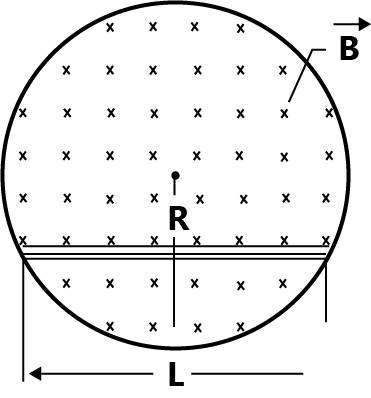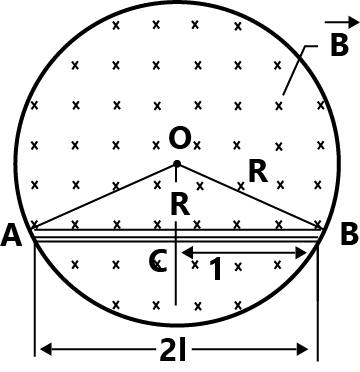
A uniform magnetic field of induction B fills a cylindrical volume of radius R. A rod AB of length 2l is placed as shown in fig. If B is changing at the rate $dB/dt$, the emf that is produced by the changing, magnetic field and that acts between the ends of the rod is:

(A) $\dfrac{{dB}}{{dt}}l\sqrt {{R^2} - {l^2}} $
(B) $\dfrac{{dB}}{{dt}}l\sqrt {{R^2} + {l^2}} $
(C) $\dfrac{1}{2}\dfrac{{dB}}{{dt}}l\sqrt {{R^2} - {l^2}} $
(D) $\dfrac{1}{2}\dfrac{{dB}}{{dt}}l\sqrt {{R^2} + {l^2}} $
Answer
219.9k+ views
Hint: First of all, we will calculate the area of triangle AOB. We will use the concept of rate of change of magnetic flux as emf or induced voltage in the cylinder. We will use $emf = A\dfrac{{dB}}{{dt}}$ formula to calculate the emf produced at both the ends of the rod.
Complete step by step answer:

Magnetic field of induction B:
It is defined as the number of magnetic field lines passing a unit surface area normally.
Emf: Rate of change of magnetic flux is known as emf. It is deNoted by $\varphi $. It is also known as voltage.
Mathematically, emf is an integral multiple of magnetic flux crossing area element dA.
${\varphi _B} = \iint\limits_A {B.dA}$
Differentiating on both the sides, we get
$emf = \dfrac{{d\varphi }}{{dt}}$$ = A\dfrac{{dB}}{{dt}}$
Magnetic field is confined in a cylinder of radius R.
Length of rod = AB = 2l
Rate of change of magnetic field $ = \dfrac{{dB}}{{dt}}$
According to figure;
Area of triangle AOB = A
Using Pythagorean Theorem,
$OC = \sqrt {O{B^2} - C{B^2}} $
OB = radius of circle = R
CB = half of length of rod AB = l
$OC = \sqrt {{R^2} - {l^2}} $
Area of a triangle $ = \dfrac{1}{2} \times base \times height$
$ = \dfrac{1}{2} \times OC \times AB$
$ = \dfrac{1}{2}2l\sqrt {{R^2} - {l^2}} $
$ = l\sqrt {{R^2} - {l^2}} $
Emf induced at the midpoint of rod AB is
$\varepsilon = \dfrac{{dB}}{{dt}}l\sqrt {{R^2} - {l^2}} $
Therefore, option A is correct.
Note:
If Pythagorean theorems have been used then $\sqrt {{R^2} + {l^2}} $ will not come in the solution. Option B and D will be wrong. If the length of rod is taken as l instead of $\dfrac{l}{2}$ then flux calculated will not be at mid-point. That’s why option A is the correct solution.
Complete step by step answer:

Magnetic field of induction B:
It is defined as the number of magnetic field lines passing a unit surface area normally.
Emf: Rate of change of magnetic flux is known as emf. It is deNoted by $\varphi $. It is also known as voltage.
Mathematically, emf is an integral multiple of magnetic flux crossing area element dA.
${\varphi _B} = \iint\limits_A {B.dA}$
Differentiating on both the sides, we get
$emf = \dfrac{{d\varphi }}{{dt}}$$ = A\dfrac{{dB}}{{dt}}$
Magnetic field is confined in a cylinder of radius R.
Length of rod = AB = 2l
Rate of change of magnetic field $ = \dfrac{{dB}}{{dt}}$
According to figure;
Area of triangle AOB = A
Using Pythagorean Theorem,
$OC = \sqrt {O{B^2} - C{B^2}} $
OB = radius of circle = R
CB = half of length of rod AB = l
$OC = \sqrt {{R^2} - {l^2}} $
Area of a triangle $ = \dfrac{1}{2} \times base \times height$
$ = \dfrac{1}{2} \times OC \times AB$
$ = \dfrac{1}{2}2l\sqrt {{R^2} - {l^2}} $
$ = l\sqrt {{R^2} - {l^2}} $
Emf induced at the midpoint of rod AB is
$\varepsilon = \dfrac{{dB}}{{dt}}l\sqrt {{R^2} - {l^2}} $
Therefore, option A is correct.
Note:
If Pythagorean theorems have been used then $\sqrt {{R^2} + {l^2}} $ will not come in the solution. Option B and D will be wrong. If the length of rod is taken as l instead of $\dfrac{l}{2}$ then flux calculated will not be at mid-point. That’s why option A is the correct solution.
Recently Updated Pages
Electricity and Magnetism Explained: Key Concepts & Applications

JEE Energetics Important Concepts and Tips for Exam Preparation

JEE Isolation, Preparation and Properties of Non-metals Important Concepts and Tips for Exam Preparation

JEE Main 2021 July 25 Shift 1 Question Paper with Answer Key

JEE Main 2021 July 22 Shift 2 Question Paper with Answer Key

States of Matter Chapter For JEE Main Chemistry

Trending doubts
JEE Main 2026: Application Form Open, Exam Dates, Syllabus, Eligibility & Question Papers

Understanding Uniform Acceleration in Physics

Derivation of Equation of Trajectory Explained for Students

Hybridisation in Chemistry – Concept, Types & Applications

Understanding the Angle of Deviation in a Prism

How to Convert a Galvanometer into an Ammeter or Voltmeter

Other Pages
JEE Advanced Marks vs Ranks 2025: Understanding Category-wise Qualifying Marks and Previous Year Cut-offs

Dual Nature of Radiation and Matter Class 12 Physics Chapter 11 CBSE Notes - 2025-26

Understanding Centrifugal Force in Physics

JEE Main Marking Scheme 2026- Paper-Wise Marks Distribution and Negative Marking Details

Degree of Dissociation: Meaning, Formula, Calculation & Uses

Ideal and Non-Ideal Solutions Explained for Class 12 Chemistry




